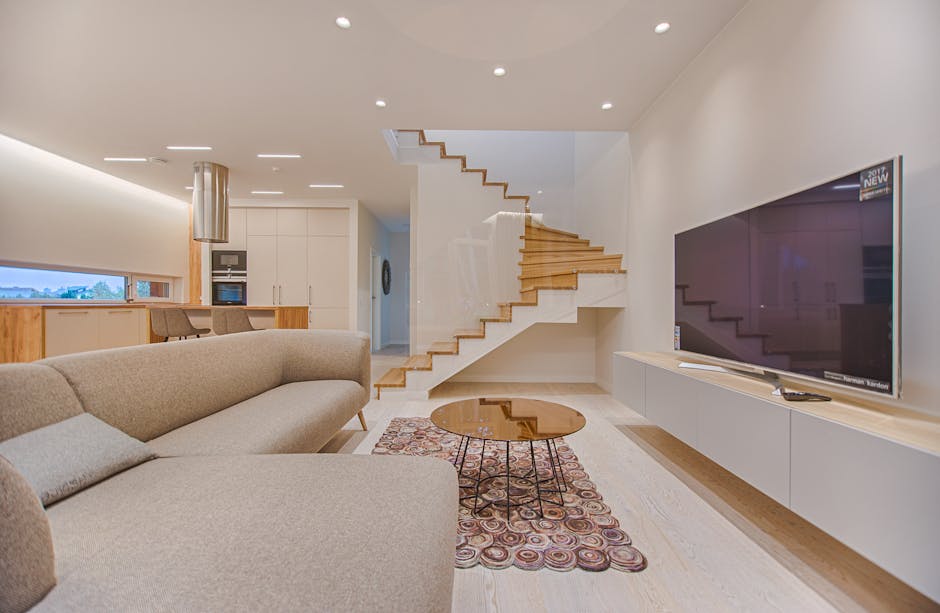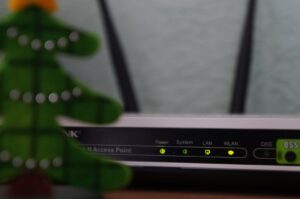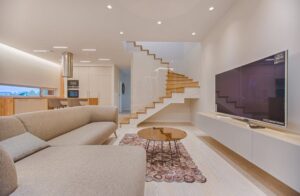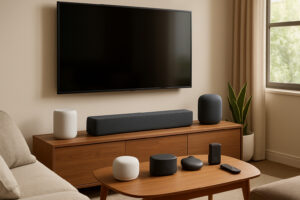Smart Ceiling Speakers: 10 Powerful Reasons to Upgrade in 2025
What Are Smart Ceiling Speakers and Why Are They Taking Over Home Audio?
Smart ceiling speakers are revolutionizing how we listen to music, podcasts, and more at home. If you want sound that blends into your ceiling and lets you control it with your phone, voice, or smart home system—this is the tech upgrade you’ve been looking for.
Quick Answer: How Do You Make Ceiling Speakers Smart?
- Choose smart-enabled ceiling speakers (Bluetooth, Wi-Fi, or with voice assistants built-in).
- Install and connect them to your home network or smart hub (like Google Home, Alexa, or Apple HomeKit).
- Control playback with an app, voice commands, or automations.
- Enjoy hands-free, multi-room, and discreet audio that fits seamlessly into your lifestyle.
Imagine walking into your kitchen and simply saying, “Play my morning playlist,”—and your ceiling comes alive with crisp sound. Modern homes are moving beyond bulky speakers to seamless, integrated solutions. The growing variety—over 1,000 “wireless ceiling speakers” on Amazon alone—proves just how popular and accessible this technology is.
As one audio enthusiast joked in a popular forum, “Wireless in-ceiling speakers are more trouble than running speaker wire… but voice control and invisible audio? That’s worth the effort.”
If you’re frustrated by clunky speakers or want premium sound that doesn’t clutter your space, smart ceiling speakers bring wireless convenience, voice control, and modern style—right overhead.

Why Read This Guide?
Whether you’re building a new home, renovating, or simply upgrading your audio setup, this guide will empower you to make informed decisions about smart ceiling speakers. We’ll walk you through:
- How to choose between active, passive, and wireless options
- Step-by-step installation and setup guidance
- Tips for integrating with your existing smart home ecosystem
- Ways to troubleshoot common issues
- Future-proofing your investment
By the end, you’ll have the knowledge to transform your ceiling into an invisible sound system that responds to your voice, phone, or automated routines—no bulky equipment required.
Understanding Smart Ceiling Speakers: Anatomy & Types
Smart ceiling speakers combine traditional in-ceiling speaker technology with modern connectivity and control features. Unlike regular ceiling speakers that simply play audio sent from an amplifier, smart versions can connect wirelessly, respond to your voice, and integrate seamlessly with your existing tech ecosystem.
Think of them as your regular ceiling speakers that went to tech college and graduated with honors. They can connect via Bluetooth or Wi-Fi, follow voice commands through Alexa or Google Assistant, integrate with your smart home setup, play synchronized music throughout your house, and even improve over time through firmware updates.

Recent scientific research on listening habits shows that modern consumers increasingly prefer seamless audio experiences that blend into their environment rather than demanding attention through visible equipment.
Active vs Passive: Which Smart Ceiling Speakers Suit Your Space?
When diving into smart ceiling speakers, you’ll quickly face a fork in the road: active or passive? This choice affects everything from installation complexity to sound quality.
Active smart ceiling speakers have built-in amplifiers, making them self-contained sound systems. They need power wired directly to each speaker, typically through AC mains, but connect directly to your network or source device without extra equipment. They’re perfect for smaller rooms or when you want a simpler setup with fewer components.
As one retailer notes, “Lithe Audio’s active ceiling speakers are among the most affordable smart ceiling speaker solutions, with prices ranging from £219.99 to £429.99 for a pair, and require no external amplifier.”
Passive smart ceiling speakers, on the other hand, need an external amplifier or receiver to work. They run on speaker wire from this amp, often delivering higher audio quality and greater flexibility for system expansion. They shine in larger spaces and whole-home systems, especially in new construction.
“Sonos In-Ceiling Architectural Speakers by Sonance, when paired with the Sonos Amp, can power up to three pairs (six speakers) from a single amplifier, maximizing coverage and efficiency,” according to product documentation.
Your choice ultimately depends on your space, budget, and audio aspirations. Active speakers are fantastic for simple setups or retrofits where extensive wiring would be a headache. Passive speakers excel when audio quality and system flexibility are your top priorities.
Wired, Wireless, and Truly Wireless Smart Ceiling Speakers
There’s often a bit of confusion about what “wireless” actually means with smart ceiling speakers. Let me clear that up with a touch of reality.
Wired smart ceiling speakers connect physically to both power and an audio source. They offer rock-solid reliability with zero latency and no batteries to worry about, but typically require professional installation. Think of them as the traditional approach with smart features added.
Semi-wireless smart ceiling speakers transmit audio wirelessly via Bluetooth or Wi-Fi but still need power wiring to each speaker. These are what most manufacturers market as “wireless” ceiling speakers. They eliminate audio cables but not power cables. As one audio forum contributor bluntly stated: “Wireless speakers still require power—either mains wiring or frequent battery recharging.”
Truly wireless smart ceiling speakers would be both battery-powered and transmit audio wirelessly. They’re extremely rare in ceiling applications for a good reason—imagine climbing a ladder every few days to recharge your ceiling speakers! While portable Bluetooth speakers can offer 12-24 hours of battery life, permanent ceiling installations with no power connection remain impractical due to battery maintenance needs.
This reality check is important when planning your installation. The term “wireless” in marketing often refers only to audio transmission, not power requirements.
Connectivity Showdown: Bluetooth vs Wi-Fi in Smart Ceiling Speakers
Your smart ceiling speakers will typically offer one of two wireless connection types: Bluetooth or Wi-Fi. Each has distinct advantages that might make one perfect for your needs.
Bluetooth speakers create a direct, simple connection between your device and the speaker. With a typical range of 30-100 feet (line of sight), they’re perfect for smaller spaces like bathrooms or bedrooms. The pairing process is straightforward, and they tend to be more affordable than their Wi-Fi counterparts. However, they’re limited to one audio source at a time and typically can’t receive firmware updates or offer advanced features.
The Lithe Audio Bluetooth ceiling speakers provide a frequency range of 65Hz-20kHz, suitable for most home audio needs.
Wi-Fi speakers connect to your home network, giving them whole-house range and higher bandwidth for better audio quality. They excel at multi-room synchronization, voice assistant integration, and can receive regular firmware updates to improve over time. The trade-off? They’re usually more expensive and require a stable home network to perform at their best.
“Wi-Fi ceiling speakers deliver better audio quality and more features but at a higher price point,” notes an industry expert. “For bathrooms or smaller spaces where convenience matters more than audiophile quality, Bluetooth models offer excellent value.”
For more detailed comparisons, check out our guide on Bluetooth vs wired audio: which one is better?
The choice ultimately depends on your priorities. If simplicity and cost matter most, Bluetooth is your friend. If you’re dreaming of a whole-home audio system with pristine sound quality, Wi-Fi is worth the investment. For multi-room setups where you want the same song playing throughout your house, Wi-Fi is almost always the better choice due to its superior synchronization capabilities.
Pros, Cons, and Creative Use Cases
When it comes to smart ceiling speakers, there’s a lot to love – but also a few things to consider before you commit. Let’s explore what makes these overhead audio solutions special, along with some real-world ways people are using them.

Advantages Over Traditional Speakers
One of the most immediate benefits of smart ceiling speakers is how they transform your space visually. As one manufacturer notes, speakers “designed and tuned in collaboration with Sonance offer natural, room-filling sound with discreet installation.” Those flush, bezel-less grilles can be painted to match your ceiling, making them practically disappear into your home design.
Say goodbye to bulky speaker cabinets eating up your floor space or cluttering your shelves. Ceiling-mounted speakers free up valuable real estate in your home while still delivering impressive sound.
The ceiling position isn’t just about aesthetics – it’s acoustically smart too. Sound disperses evenly throughout the room from above, creating consistent audio coverage. KEF Uni-Q drivers, for example, deliver “superior stereo imaging for unconventional room layouts,” solving those awkward space problems many of us face.
Voice control integration might be my favorite perk. There’s something magical about walking into your kitchen and simply saying, “Hey Google, play jazz” – and having your ceiling respond with perfect sound. No fumbling for remote controls or opening apps.
The automation possibilities really shine when you connect your smart ceiling speakers to your broader smart home system. Imagine walking through your front door after work and having your favorite wind-down playlist automatically start playing, following you from room to room as you move through your evening routine.
Potential Drawbacks & Misconceptions
Let’s be honest – installing smart ceiling speakers isn’t as simple as plugging in a portable Bluetooth speaker. You’ll likely be cutting holes in your ceiling, running wires, and possibly hiring a professional. It’s an investment of both time and money.
Perhaps the biggest misconception is around the term “wireless.” As one frustrated forum user pointed out, “Even if they receive audio wirelessly, they still need power—either mains wiring or batteries that need regular recharging.” True wireless ceiling speakers remain something of a unicorn in the audio world.
The price tag can cause sticker shock too. Quality smart ceiling speakers plus professional installation often runs significantly higher than traditional speaker setups. The Sonos In-Ceiling Speakers come in at $659 for the 6″ model and $999 for the 8″ model – and that doesn’t include the required Sonos Amp at $699.
When something goes wrong with a regular speaker, troubleshooting is relatively straightforward. With ceiling speakers, accessing components for repair can be challenging, sometimes requiring removal of drywall or ceiling materials.
Safety should never be overlooked either. As one expert cautions, “Follow building codes when installing powered devices behind drywall.” Electrical components hidden in your ceiling need proper installation to prevent fire hazards.
Inspiring Real-World Scenarios
Despite the challenges, smart ceiling speakers open up some truly exciting possibilities for everyday living.
Transform your bathroom into a personal spa experience with moisture-resistant models like the “Lithe Audio Pro Series IP44 Bathroom Wi-Fi Ceiling Speaker.” These specially designed units can handle the steam and humidity of your morning shower while delivering crystal-clear audio for your getting-ready playlist.

Home theater enthusiasts are creating truly immersive Dolby Atmos setups by combining in-wall and smart ceiling speakers. The effect is remarkable – sound that seems to come from everywhere without visible equipment, creating a cinema experience that rivals commercial theaters.
Parents have finded an unexpected benefit: safety. Unlike traditional speakers that curious little hands can knock over (or speakers with accessible wires that become tempting pull toys), ceiling-mounted models keep all components safely out of reach – perfect for playrooms and children’s bedrooms.
Smart morning routines become effortless with ceiling audio. Imagine being gently awakened by gradually increasing volume, then having the day’s weather and news read to you as you stretch. As you head to the bathroom, the audio follows you seamlessly, then continues into the kitchen as you prepare breakfast – all without touching a single button.
When entertaining, smart ceiling speakers shine by providing perfectly distributed background music that improves the atmosphere without dominating it. Your guests will enjoy conversation without shouting over speakers, and you’ll appreciate the clean, uncluttered entertaining space free of audio equipment.
Whether you’re renovating, building new, or just looking to upgrade your audio experience, ceiling-mounted smart speakers offer a unique blend of aesthetics and functionality that’s hard to beat – if you’re willing to make the investment.
Planning Your Smart Ceiling Speaker Project
Ready to bring smart ceiling speakers into your home? Before you start cutting holes in your ceiling, let’s talk about how to plan your project properly. Taking time to plan now will save you headaches (and ceiling patches) later!
Budget vs Mid-Range vs High-End Feature Sets
Not all smart ceiling speakers are created equal, and your budget will largely determine what features you can expect:
For the budget-conscious ($100-300 per pair), you’ll find basic options like the Herdio 6.5″ Bluetooth Ceiling Speaker System. These speakers offer simple wireless playback with smaller drivers (usually 5-6.5″) and limited frequency response around 65Hz-20kHz.
“Use budget speakers in hallways or bedrooms for ambient background music,” is advice I often hear from retailers, and it makes perfect sense. These spaces typically don’t need audiophile-quality sound.
Step up to mid-range options ($300-700 per pair), like Lithe Audio Wi-Fi Ceiling Speakers, and you’ll gain Wi-Fi connectivity, voice assistant compatibility, and multi-room synchronization. The sound quality improves noticeably too.
As one industry expert told me, “Lithe Audio active ceiling speakers work wonderfully for smaller rooms and background music, while passive speakers with external amps deliver the goods for larger spaces and higher audio quality.” This middle ground offers excellent value for most homes.
For the true audio enthusiasts, high-end options ($700+ per pair) from brands like Sonos, KEF, and Bowers & Wilkins deliver premium driver technology, extended frequency response, and sophisticated digital signal processing. The Sonos In-Ceiling Speakers, for example, boast impressive frequency response (36Hz-20kHz for the 6.5″ model), creating full, rich sound throughout your space.

Installation Requirements & Challenges
Installing smart ceiling speakers isn’t quite as simple as hanging a picture. You’ll need to consider your ceiling’s structure first—check joist direction and spacing, measure ceiling depth to ensure your speakers will fit, and identify any obstacles like pipes or wires that might be hiding up there.
Planning wiring routes is crucial, especially for “wireless” speakers that still need power. Some clever homeowners use crown molding as a hidden cable raceway—a tip I wish I’d known before my first installation! If you’re building new, coordinate with your electrician early to make life easier.
You’ll need some basic tools: a stud finder, drywall saw or hole saw, fish tape for pulling wires, voltage tester, and the mounting templates that come with your speakers. As one forum contributor succinctly put it, “Cut drywall, run speaker wire, patch and paint for a concealed wired installation.” Sounds simple, but take your time with each step.
For challenging spaces like bathrooms or covered patios, remember to use moisture-resistant speakers. Look for an IP44 rating for bathrooms, while outdoor areas need IP65 or higher. No one wants to replace water-damaged speakers after their first steamy shower!
Want to learn more about improving your overall home audio setup? Check out our comprehensive guide to home audio improvement.
Powering Up Safely
Power requirements for smart ceiling speakers vary dramatically depending on whether you choose passive or active models:
Passive speakers connect to an external amplifier via speaker wire (typically 12-16 gauge depending on distance). They need an amp that matches their impedance (usually 4-8 ohms). Popular options include the Sonos Amp, WiiM Amp, or Bluesound Powernode. The advantage? All your power handling happens in one accessible location.
Active speakers, on the other hand, need direct AC power at each speaker location. This often means hiring a licensed electrician, as you’ll need to comply with building codes for in-ceiling electrical connections. As one expert cautions, “Follow building codes when installing powered devices behind drywall.” This isn’t just bureaucratic red tape—it’s about preventing fire hazards in your home.
The good news? Many modern smart ceiling speakers include eco power modes that reduce standby consumption when they’re not blasting your favorite tunes.
The “wireless” in wireless ceiling speakers typically refers only to the audio transmission—not the power source. Unless you’re willing to recharge batteries regularly (a real pain for ceiling-mounted units), you’ll need to plan for power delivery to each speaker location.
With proper planning, your smart ceiling speakers will deliver years of invisible, room-filling sound that makes your home feel magical. Just imagine walking into your kitchen and saying, “Play my cooking playlist,” without a black box or visible speaker in sight!
Step-by-Step Setup & Control Walkthrough
So you’ve mounted your smart ceiling speakers and now you’re wondering, “What’s next?” Let’s walk through bringing these clever little devices to life—from first power-up to creating a whole-home audio experience you can control with just your voice.
Getting started is simpler than you might think. First, download your speaker manufacturer’s companion app. Wi-Fi-enabled speakers typically need their specific app, while Bluetooth models play nice with most music apps you already use.
Once your app is ready, make sure all your smart ceiling speakers are receiving power. For active models, this means they’re properly plugged in, while passive speakers need their connected amplifier powered on. That little power light is a welcome sight!
For Wi-Fi models, the app will guide you through connecting to your home network. Some speakers require a quick button press to enter setup mode, while others cleverly use Bluetooth for the initial Wi-Fi configuration—a bit like a digital handshake to get acquainted with your network.
If you’ve opted for Bluetooth speakers, you’ll need to put them in pairing mode (usually by pressing and holding a button) and then connect through your phone or tablet’s Bluetooth settings. Many modern Bluetooth ceiling speakers allow pairing multiple units for a more immersive stereo experience.

Premium smart ceiling speakers often include room calibration features (Sonos calls theirs “Trueplay”). These clever systems analyze your room’s acoustics and automatically adjust equalizer settings for optimal sound. It’s like having a sound engineer fine-tune your system specifically for your space!
For homes with multiple speakers, take time to create logical speaker groups. Naming each speaker or group makes control more intuitive—”Kitchen,” “Living Room,” or “Downstairs” are much easier to remember than “Speaker 1” and “Speaker 2” when you’re trying to start your morning playlist.
Integrating with Google, Alexa, and HomeKit
Making your smart ceiling speakers work with voice assistants transforms how you interact with them. No more hunting for your phone—just ask and receive!
For Google Home integration, first ensure your speakers are set up in their native app, then open the Google Home app and tap the “+” icon to add a device. Select your speaker brand, follow the prompts, and soon you’ll be saying, “Hey Google, play my cooking playlist in the kitchen” while your hands are busy chopping vegetables.
Amazon Alexa users will open the Alexa app, steer to Devices > Add Device, select your speaker type, and follow the connection steps. Once linked, you can create speaker groups and use natural commands like “Alexa, set living room speakers to volume 5” when the neighbors complain.
Apple fans with HomeKit-compatible speakers can add them via the Home app on their iPhone or iPad. Some speakers offer direct HomeKit integration, while others work through AirPlay 2 compatibility. Either way, you’ll soon be saying, “Hey Siri, play something relaxing in the bedroom” as you wind down for the night.
One manufacturer notes, “After pairing one master speaker via Bluetooth, a second speaker can be linked using a simple speaker cable for stereo setup.” This flexibility shows how these systems can grow with your needs—start simple and expand later.
Mastering Multi-Room & Surround Sync
Creating a seamless audio experience throughout your home requires attention to your network and speaker configuration. Think of your Wi-Fi network as the conductor that keeps all your smart ceiling speakers playing in perfect harmony.
Network stability is crucial—Wi-Fi speakers rely on your network for synchronization. In larger homes, consider a mesh Wi-Fi system that eliminates dead zones. For the most reliable performance, wired Ethernet connections to your access points can make a dramatic difference in stability.
Managing latency (that annoying delay between speakers) varies by brand. Premium systems like Sonos have sophisticated algorithms that maintain perfect sync, while budget options might struggle with complex setups. Some systems offer adjustable delay settings to fine-tune the experience.
For home theater enthusiasts, position your ceiling speakers according to Dolby Atmos guidelines and use an AV receiver that supports ceiling speaker configurations. Running the receiver’s calibration routine will time-align all speakers for a truly immersive experience where sound moves seamlessly around the room.
A common question I hear is, “How do smart ceiling speakers handle audio synchronization in multi-room setups?” The answer depends on both your speaker quality and network performance. Premium systems maintain tight synchronization even across multiple rooms, while budget options might be better kept to single-room applications.
Troubleshooting Common Issues
Even the best technology occasionally needs a helping hand. If your smart ceiling speakers start acting up, these solutions should get you back to enjoying your music in no time.
When audio dropouts interrupt your favorite song, first check your Wi-Fi signal strength near the speakers. Reducing network congestion by limiting streaming on other devices can help, as can moving your router closer or adding mesh nodes. A quick firmware update might also resolve the issue—manufacturers regularly improve performance through software updates.
For stubborn connection problems, the classic IT advice applies: restart both your speakers and router. Verify your speakers are within network range and that your router isn’t overwhelmed by too many connected devices. Some older routers struggle with the protocols needed for synchronized multi-room audio.
If sound quality disappoints, run the room calibration if available or manually adjust EQ settings in the app. Check for interference from nearby devices (microwaves and cordless phones are common culprits) and ensure your speaker positioning isn’t blocked by furniture or decorations.
When voice control starts ignoring you, check that your voice assistant is properly linked to your speaker system. Verify microphone permissions are enabled and that your wake word settings haven’t changed. A quick update to your assistant’s software might also resolve recognition issues.
As one industry expert notes, “Over time, firmware updates may improve your speakers’ performance and add new features.” This highlights one of the key advantages of Wi-Fi connected speakers over Bluetooth-only models—they get smarter over time through software improvements.
With your smart ceiling speakers properly set up and connected to your preferred voice assistant, you’re ready to enjoy music that seems to flow from the very air around you—no visible equipment, no clutter, just beautiful sound at your command.
Best Smart Ceiling Speaker Features to Prioritize in 2025
Shopping for smart ceiling speakers in 2025? The technology has come a long way, and certain features now stand head and shoulders above the rest. Let’s talk about what really matters when you’re looking to invest in ceiling audio that won’t feel outdated next year.
Sound quality remains king, of course. Look for speakers with wide dispersion drivers that offer coverage angles of 90° or more. This ensures everyone in your room gets the same great sound experience, whether they’re directly beneath a speaker or off to the side. You don’t want audio “hot spots” where only one seat in the room gets the perfect sound.
“I replaced my old ceiling speakers with wide-dispersion models, and the difference is night and day,” one homeowner told me. “Now music sounds balanced everywhere in my kitchen, not just directly under each speaker.”
High-resolution audio support has become increasingly important as streaming services up their game. Speakers supporting 24-bit/96kHz or higher audio will keep you future-proofed as better-quality streams become standard. Your ears will thank you for the extra detail and clarity these higher resolutions provide.
Matter compatibility might not sound exciting, but trust me—it’s a game-changer. This relatively new smart home standard ensures your speakers will work with different ecosystems, meaning your investment stays relevant even if you switch from Google to Apple or Amazon down the road.
Voice control has moved from novelty to necessity. Premium smart ceiling speakers now come with built-in microphones that let you control your music, ask questions, or manage other smart home devices without lifting a finger. The convenience factor here can’t be overstated—especially when your hands are full in the kitchen or you’re relaxing in the bath.
Speaking of bathrooms, pay attention to those IP ratings. For dry rooms, some moisture resistance offers peace of mind, but for bathrooms, look for at least IP44 certification. For outdoor patio installations, aim even higher with IP65 or better. Nothing kills a speaker faster than moisture damage.
“The Sonos In-Ceiling Speakers offer a frequency response of 36 Hz-20 kHz (6.5″ model) and up to 29 Hz-20 kHz (8″ model), providing full-range sound for home audio applications,” notes one product specification. This wide frequency range ensures you’ll hear everything from deep bass notes to the highest treble details.

Don’t overlook the importance of adaptive EQ technology. Speakers that automatically adjust to your room’s acoustics save you from tedious manual tuning and ensure optimal sound regardless of your ceiling height, room shape, or furniture arrangement.
Perhaps most importantly in our rapidly evolving tech landscape, choose speakers that support over-the-air updates. This single feature can extend the lifespan of your investment by years, as manufacturers push new features, fix bugs, and maintain compatibility with emerging services long after installation.
Future-Proof Tech: What’s Coming Next for Smart Ceiling Speakers
The smart ceiling speaker market never stands still. Several exciting technologies are on the horizon that could transform how we experience audio in our homes.
WiSA Technology (Wireless Speaker and Audio Association) is gaining momentum, promising truly wireless high-resolution audio with perfect synchronization between speakers. This could eventually eliminate the need for speaker wires entirely, making installation dramatically simpler.
Spatial Audio processing is moving beyond headphones into home speakers. Apple’s implementation and similar technologies from other companies create a more immersive, three-dimensional soundstage that makes music and movies feel like they’re happening all around you, not just coming from specific points in your ceiling.
AI is changing speaker performance too. AI-powered room correction uses machine learning to continuously optimize sound based not just on static room measurements but on your actual listening patterns and preferences. Your system literally gets smarter the more you use it.
Wireless power transmission remains the holy grail for truly wireless ceiling speakers. While still in early development stages, this technology could eventually eliminate power cables entirely. As one forum contributor realistically notes: “Wireless power demos often target 5–20 W devices, far below the 100+ W speakers need.” The technology isn’t quite there yet for high-power audio applications, but it’s advancing rapidly.
Beamforming audio technology is particularly fascinating—it can direct sound to specific locations within a room, creating personalized listening zones. Imagine your partner enjoying a podcast in one corner while you listen to music in another, all from the same ceiling speaker system.
Shopping Checklist: From Cart to Ceiling
Ready to buy your smart ceiling speakers? Let’s make sure you’ve covered all the bases with this practical checklist.
Start with your room measurements. Know your ceiling height and square footage to determine how many speakers you’ll need. Most manufacturers provide coverage recommendations based on room size. Don’t forget to measure the distance from primary listening positions—this affects speaker placement for optimal sound.
Pay close attention to speaker specifications. Driver size matters—5″ models work well in smaller rooms, while 6.5″ or 8″ drivers deliver better bass response in larger spaces. Check frequency response range (wider is better) and power handling capacity to ensure compatibility with your amplifier.
Before ordering, verify installation requirements. Measure your ceiling cavity to ensure sufficient mounting depth clearance. Most manufacturers provide cut-out templates, but knowing dimensions in advance prevents nasty surprises. For passive speakers, check recommended wire gauge (typically 14-16 gauge for runs under 50 feet), and for active models, plan for junction box placement.
If you’re going with passive speakers, think about your amplification needs. “The Sonos Amp can power up to three pairs (six speakers) from a single amplifier, maximizing coverage and efficiency,” notes one product description. Make sure your amp has sufficient power output per channel and can support the number of zones you’re planning.
Finally, double-check compatibility with your existing tech ecosystem. Verify that your chosen speakers work with your preferred voice assistant, support your favorite streaming services, and will integrate smoothly with any existing audio equipment.
The extra time spent planning now will save you headaches later and ensure your smart ceiling speakers deliver years of enjoyable, hassle-free listening.
Frequently Asked Questions about Smart Ceiling Speakers
Are smart ceiling speakers truly wireless?
The term “wireless” can be a bit misleading when it comes to smart ceiling speakers. In reality, most aren’t completely cord-free. While they can receive audio wirelessly through Bluetooth or Wi-Fi, they still need power to function.
Active speakers require a direct electrical connection to your home’s wiring, while passive speakers need cables running to an amplifier. As one refreshingly honest forum user put it, “Wireless speakers still require power—either mains wiring or frequent battery recharging.”
Some manufacturers do offer battery-powered ceiling speakers, but these aren’t particularly practical for permanent installations. Imagine climbing up a ladder every few weeks to remove, recharge, and reinstall your ceiling speakers! When you see “wireless” in product descriptions, they’re typically referring to wireless audio transmission, not power delivery.
Can I install them in a bathroom or outdoor patio?
Absolutely you can—but you’ll need to choose speakers designed to handle moisture. For bathrooms, look for speakers with at least an IP44 rating, which provides protection against water splashes from any direction. Lithe Audio’s “Pro Series IP44 Bathroom Wi-Fi Ceiling Speakers” are specifically built for steamy shower singalongs.
For outdoor spaces like covered patios, you’ll want to step up to IP65 or higher-rated speakers. These can withstand more direct moisture exposure, though they should still be installed in covered areas rather than directly exposed to rain or snow.
One manufacturer explains, “IP44 certification indicates protection against splashing water, suitable for bathroom installations.” It’s not just the speakers themselves that need protection—any power connections should also be properly rated for the environment where they’ll be used. When in doubt, consult an electrician who understands both audio and electrical code requirements.
How do I avoid audio lag in multi-room setups?
There’s nothing more annoying than hearing your favorite song playing at slightly different times as you walk from room to room. Fortunately, there are several ways to minimize audio lag with smart ceiling speakers:
Stick with speakers from the same ecosystem whenever possible. Brands like Sonos have developed sophisticated proprietary technology specifically designed to keep audio perfectly synchronized across multiple rooms.
Your home network plays a crucial role too. Wi-Fi dead spots can cause frustrating lag issues, so consider investing in a mesh network system if you have a larger home. Also try to reduce network congestion by limiting video streaming or large downloads while using your multi-room audio.
Whenever possible, use wired connections for your main hub or amplifier. An Ethernet connection to your router provides more stability than Wi-Fi alone.
Don’t forget to keep your speaker firmware updated! Manufacturers regularly release updates that improve synchronization performance.
If perfect sync is a top priority for your whole-home audio system, premium options like Sonos and Bluesound have earned their reputation for minimal latency. They cost more, but the seamless experience as you move throughout your home makes the investment worthwhile for many music lovers.
Conclusion
Smart ceiling speakers truly represent the perfect marriage of sleek design and modern technology for today’s homes. After exploring all the options, you now understand the key differences between active and passive models, connectivity choices, and what it takes to install these audio gems in your ceiling.
I love how these speakers can transform a room without taking up any visual space. Whether you’re just looking to add music to your kitchen or creating an immersive whole-home audio experience, ceiling-mounted speakers offer something traditional speakers simply can’t—they disappear while delivering impressive sound from above.
Throughout this guide, we’ve uncovered some important truths about smart ceiling speakers. The term “wireless” typically refers to how they receive audio signals, not how they’re powered. Most still need either power cables or speaker wires running to them—a reality check worth remembering as you plan your project.
When choosing your system, take time to match speaker specifications to your actual room dimensions. A small bathroom needs different speakers than a large open-concept living area. And don’t forget to think ahead about expansion—starting with speakers that can easily integrate with more zones later will save you headaches down the road.
For spaces like bathrooms or covered patios, those IP moisture ratings aren’t just marketing jargon—they’re essential protection for your investment. An IP44 rating for bathroom installations can mean the difference between years of enjoyment and premature failure.
While the DIY route appeals to many of us (myself included!), I’ve found that professional installation often pays for itself, especially for complex multi-room setups. The peace of mind knowing everything is correctly wired and optimally positioned is worth considering.
At The Techie Genius, we firmly believe technology should improve your life, not complicate it. Smart ceiling speakers perfectly embody this philosophy by delivering exceptional sound that integrates seamlessly into your home and daily routines.
Are you ready to lift your audio experience? Start planning your smart ceiling speaker system today, and remember we’re here to help if questions arise as you start on this exciting upgrade.
For more in-depth guidance on home audio and smart technology, browse through our complete collection of audio guides.







